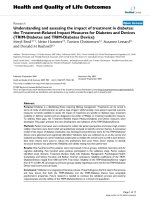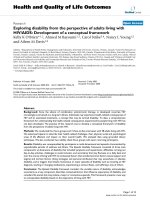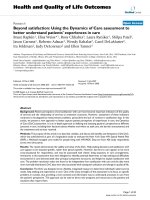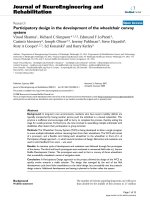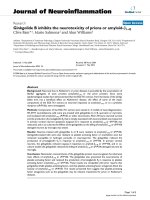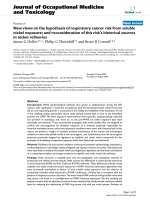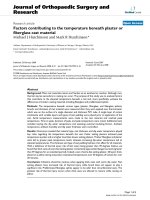báo cáo hóa học: " Ginkgolide B inhibits the neurotoxicity of prions or amyloid-β1-42" pdf
Bạn đang xem bản rút gọn của tài liệu. Xem và tải ngay bản đầy đủ của tài liệu tại đây (293.86 KB, 8 trang )
BioMed Central
Page 1 of 8
(page number not for citation purposes)
Journal of Neuroinflammation
Open Access
Research
Ginkgolide B inhibits the neurotoxicity of prions or amyloid-β
1-42
Clive Bate*
1
, Mario Salmona
2
and Alun Williams
3
Address:
1
Department of Veterinary Pathology, Glasgow University Veterinary School, Bearsden Road, Glasgow, UK. G61 1QH,
2
Department of
Molecular Biochemistry and Pharmacology, Istituto di Ricerche Farmacologiche "Mario Negri", Via Eritrea 62, 20157 Milano, Italy and
3
Department of Pathology and Infectious Diseases, Royal Veterinary College, Hawkshead Lane, North Mymms, Herts, UK. AL9 7TA
Email: Clive Bate* - ; Mario Salmona - ; Alun Williams -
* Corresponding author
Abstract
Background: Neuronal loss in Alzheimer's or prion diseases is preceded by the accumulation of
fibrillar aggregates of toxic proteins (amyloid-β
1-42
or the prion protein). Since some
epidemiological studies have demonstrated that the EGb 761 extract, from the leaves of the Ginkgo
biloba tree, has a beneficial effect on Alzheimer's disease, the effect of some of the major
components of the EGb 761 extract on neuronal responses to amyloid-β
1-42
, or to a synthetic
miniprion (sPrP106), were investigated.
Methods: Components of the EGb 761 extract were tested in 2 models of neurodegeneration.
SH-SY5Y neuroblastoma cells were pre-treated with ginkgolides A or B, quercetin or myricetin,
and incubated with amyloid-β
1-42
, sPrP106, or other neurotoxins. After 24 hours neuronal survival
and the production of prostaglandin E
2
that is closely associated with neuronal death was measured.
In primary cortical neurons apoptosis (caspase-3) in response to amyloid-β
1-42
or sPrP106 was
measured, and in co-cultures the effects of the ginkgolides on the killing of amyloid-β
1-42
or sPrP106
damaged neurons by microglia was tested.
Results: Neurons treated with ginkgolides A or B were resistant to amyloid-β
1-42
or sPrP106.
Ginkgolide-treated cells were also resistant to platelet activating factor or arachidonic acid, but
remained susceptible to hydrogen peroxide or staurosporine. The ginkgolides reduced the
production of prostaglandin E
2
in response to amyloid-β
1-42
or sPrP106. In primary cortical
neurons, the ginkgolides reduced caspase-3 responses to amyloid-β
1-42
or sPrP106, and in co-
culture studies the ginkgolides reduced the killing of amyloid-β
1-42
or sPrP106 damaged neurons by
microglia.
Conclusion: Nanomolar concentrations of the ginkgolides protect neurons against the otherwise
toxic effects of amyloid-β
1-42
or sPrP106. The ginkgolides also prevented the neurotoxicity of
platelet activating factor and reduced the production of prostaglandin E
2
in response to platelet
activating factor, amyloid-β
1-42
or sPrP106. These results are compatible with prior reports that
ginkgolides inhibit platelet-activating factor, and that platelet-activating factor antagonists block the
toxicity of amyloid-β
1-42
or sPrP106. The results presented here suggest that platelet-activating
factor antagonists such as the ginkgolides may be relevant treatments for prion or Alzheimer's
diseases.
Published: 11 May 2004
Journal of Neuroinflammation 2004, 1:4
Received: 08 March 2004
Accepted: 11 May 2004
This article is available from: />© 2004 Bate et al; licensee BioMed Central Ltd. This is an Open Access article: verbatim copying and redistribution of this article are permitted in all media
for any purpose, provided this notice is preserved along with the article's original URL.
Journal of Neuroinflammation 2004, 1 />Page 2 of 8
(page number not for citation purposes)
Background
The symptoms of Alzheimer's disease (AD), or the trans-
missible spongiform encephalopathies, otherwise known
as the prion diseases, are thought to arise after the dys-
function or degeneration of neurons. In these diseases,
extracellular aggregates of insoluble, misfolded, fibrillar
proteins are thought to cause the neuronal damage. In
AD, fibrils consisting of amyloid-β peptides are formed
following the cleavage of the amyloid precursor protein
by γ-secretases [1]. In the prion diseases the cellular prion
protein (designated PrP
C
) is converted into a disease-
related isoforms (PrP
d
), in a process whereby a portion of
the α-helix and random coil structure in PrP
C
is refolded
into a β-pleated sheet [2].
Standard techniques to study the mechanisms of neuronal
loss in vitro include incubating neuronal cells with pep-
tides derived from the PrP protein [3] or from amyloid-β
[4]. The neuronal injury induced by these peptides
include events characteristic of apoptosis such as surface
blebbing, chromatin condensation and DNA fragmenta-
tion [3]. In the present study we examined the neurotox-
icity of fibrillar peptides by exposing the SH-SY5Y
neuroblastoma cell line, or murine primary cortical neu-
rons, to amyloid-β
1-42
, to a peptide derived from the
human PrP protein (HuPrP82-146), or to a synthetic
murine "miniprion" (sPrP106) [5]. Further studies exam-
ined the interactions between amyloid-β
1-42
or sPrP106
damaged neurons and microglia.
Extracts from the leaves of the Ginkgo biloba tree are
becoming increasingly popular as a treatment that is
claimed to reduce memory loss and the symptoms of mild
cognitive disorders including AD. However, there remains
considerable debate regarding the mechanisms of action
of these preparations, or even whether such preparations
have any clinical benefit. While some published studies
conclude that the use of a standardized extract of the
leaves of the Ginkgo biloba tree (EGb 761) reduces the
symptoms of mild cognitive disorders including AD [6-8],
more recent studies have failed to show clinical benefit
with other preparations [9]. In tissue culture studies the
EGb 761 extract reduces amyloid-β aggregation and cas-
pase-3 activity [10], and protects hippocampal neurons
against amyloid-β [11]. Since the EGb 761 extract con-
tains many compounds including ginkgolides and the fla-
vonoglycosides myricetin or quercetin, it is not clear
which of these compounds provide the protective effect.
In the present study, the main components of the EGb
761 extract were examined for their effects on SH-SY5Y
neuroblastoma cells, primary cortical neurons and micro-
glia. Low concentrations of the ginkgolides A or B were
shown to protect neurons against PrP peptides or amy-
loid-β
1-42
, and to reduce microglial killing of damaged
neurons.
Methods
Cell lines
The human neuroblastoma SH-SY5Y cell line (European
Collection of Cell Cultures) was grown in RPMI-1640 cul-
ture medium supplemented with 2 mM glutamine, 100
U/ml penicillin, 100 µg/ml streptomycin and 5% foetal
calf serum (FCS). Cells were plated at 5 × 10
4
cells/well
into 96 well plates and allowed to adhere overnight before
use. Cells were pre-treated with test compounds for 3
hours before the addition of peptides and 24 hours later
the survival of neurons was determined by treating cul-
tures with WST-1 from Roche Diagnostics Ltd (Lewes, UK)
for 3 hours. The amount of dye formed correlates to the
number of metabolically active cells. Optical density was
read on a spectrophotometer and percentage survival was
calculated by reference to untreated cells incubated with
WST-1 (100%). To measure prostaglandin E
2
production
SH-SY5Y cells were plated at 5 × 10
5
cells/well in 24 well
plates and allowed to adhere overnight before use. Cells
were treated with test compounds for 3 hours before the
addition of peptides and 24 hours later prostaglandin E
2
levels were determined using a competitive enzyme
immunoassay kit (Amersham Biotech, UK) according to
the manufacturer's instructions.
Primary neuronal cultures
Primary cortical neurons were prepared from embryonic
brains as previously described [12]. After 24 hours media
was changed to neurobasal medium containing B27 com-
ponents (NBM) (Invitrogen, Paisley, UK) and 2 mM
glutamine. Mature cultures were pre-treated with test
compounds for 3 hours before the addition of peptides;
caspase-3 activity was measured using a flourometric
immunosorbent enzyme assay (FIENA) kit as per the
manufacturer's instructions (Roche Diagnostics, Lewes,
UK) 24 hours later. For cell survival assays, microglia (pre-
pared by dissociating the cerebral cortices of newborn
129/Ola mice as previously described [12]) were added to
peptide treated neuronal cultures in the ratio of 1 micro-
glia to 10 neuronal cells. Medium was replaced after 48
hours, and after 4 days microglia were removed by shak-
ing (260 r.p.m for 30 minutes). The survival of neurons
was then determined by treating cultures with WST-1.
Peptides
Peptides containing amino acid residues 82 to 146 of the
human PrP protein (HuPrP82-146), a control peptide
(HuPrP82-146 scrambled), and a synthetic miniprion
(sPrP106) derived from the murine PrP sequence were
used. A peptide containing amino acids 1 to 42 of the
amyloid-β protein (amyloid-β
1-42
) and a control peptide
(amyloid-β
42-1
) were obtained from Bachem (St Helens,
UK).
Journal of Neuroinflammation 2004, 1 />Page 3 of 8
(page number not for citation purposes)
Drugs
Ginkgolide B, myricetin, quercetin, staurosporine, arachi-
donic acid, platelet-activating factor (PAF) and hydrogen
peroxide were obtained from Sigma (Poole, UK).
Ginkgolide A was obtained from Calbiochem (Notting-
ham, UK).
Statistical analysis
Comparison of treatment effects were carried out using
one and two way analysis of variance techniques as appro-
priate. Post hoc comparisons of means were performed as
necessary.
Results
Ginkgolide-treated neurons are resistant to PrP peptides/
amyloid-
β
1-42
SH-SY5Y cells were pre-treated with the ginkgolides A or
B, or with the flavonoglycosides, myricetin or quercetin
(at concentrations which did not affect the growth rate or
survival of these cells) before the addition of 5 µM
sPrP106, 10 µM HuPrP82-146 or 10 µM amyloid-β
1-42
.
The survival of cells pre-treated with 1 µM ginkgolide A
and incubated with sPrP106, HuPrP82-146 or amyloid-
β
1-42
was significantly higher than that of untreated cells
incubated with these peptides. Cells pre-treated with 1 µM
ginkgolide B were also resistant to the otherwise toxic
effects of 5µM sPrP106, 10 µM HuPrP82-146 or 10 µM
amyloid-β
1-42
. Pre-treatment of cells with 25 µM myrice-
tin, or 25 µM quercetin, did not affect the toxicity of
sPrP106, HuPrP82-146 or amyloid-β
1-42
(Table 1). The
survival of cells was not affected by the control peptides
HuPrP82-146 scrambled or amyloid-β
42-1
(data not
shown).
In further studies cells were pre-treated with different con-
centrations of the ginkgolides prior to the addition of 20
µM amyloid-β
1-42
. Pre-treatment with ginkgolides A or B
resulted in a dose-dependent increase in neuronal survival
(Fig 1). At concentrations less than 1 µM, the survival of
cells treated with ginkgolide B was significantly greater
than that of cells treated with ginkgolide A. Pre-treatment
with ginkgolide B also resulted in a dose-dependent
increase in neuronal survival in response to 5 µM sPrP106
or 10 µM HuPrP82-146, as well as to 10 µM amyloid-β
1-
42
(Fig 2).
Table 1: Ginkgolide-treated SH-SY5Y cells are resistant to PrP peptides/amyloid-β
1-42
: The survival of SHSY-5Y cells in control medium,
medium containing 1 µM ginkgolides A, 1 µM ginkgolide B, 25 µM myricetin or 25 µM quercetin for 3 hours and subsequently incubated
for 24 hours with 5 µM sPrP106, 10 µM HuPrP82-146 or 10 µM amyloid-β
1-42
. Values shown represent the percentage survival of cells
compared to untreated cells. Each value is the mean ± SD from triplicate experiments repeated four times (12 observations).
untreated sPrP106 HuPrP82-146 amyloid-β
1-42
control medium 100 ± 3 69 ± 4 64 ± 6 48 ± 10
ginkgolide A 101 ± 5 99 ± 3** 101 ± 2** 99 ± 4**
ginkgolide B 99 ± 3 99 ± 5** 98 ± 3** 96 ± 3**
myricetin 101 ± 7 67 ± 3 65 ± 3 46 ± 5
quercetin 100 ± 4 66 ± 4 66 ± 5 44 ± 5
** = Cell survival significantly greater (p < 0.05) than cells incubated with peptides in the absence of drugs.
Ginkgolides protect neurons against amyloid-β
1-42
Figure 1
Ginkgolides protect neurons against amyloid-β
1-42
:
The survival of SH-SY5Y cells pre-treated with different con-
centrations of ginkgolide A (shaded circles) or ginkgolide B
(open circles) for 3 hours, and thereafter incubated with 20
µM amyloid-β
1-42
. Cell survival was measured 24 hours later
using the WST-1 method. Each value represents the mean
percentage cell survival ± SD from triplicate experiments
repeated four times (12 observations).
Journal of Neuroinflammation 2004, 1 />Page 4 of 8
(page number not for citation purposes)
To determine if the protective effect of ginkgolide B could
be overcome by increasing the concentration of toxic pep-
tides, different concentrations of amyloid β
1-42
or sPrP106
were added to untreated SH-SY5Y cells or to cells pre-
treated with 1 µM ginkgolide B. Both amyloid β
1-42
and
sPrP106 caused a dose-dependent reduction in the sur-
vival of untreated cells, however, even high concentra-
tions of amyloid β
1-42
or sPrP106 (80 µM) did not reduce
the survival of cells treated with 1 µM ginkgolide B (Fig 3).
Ginkgolides protect SH-SY5Y cells against the toxicity of
PAF or arachidonic acid
The toxicity of PrP peptides requires the activation of
phospholipase A
2
and the subsequent release of neurotox-
ins such as arachidonic acid and PAF [13]. To determine if
ginkgolides blocked the activity of such neurotoxins, SH-
SY5Y cells were pre-treated with 1 µM ginkgolide B, and
subsequently exposed to different concentrations of
hydrogen peroxide, arachidonic acid, PAF or stau-
rosporine. Pre-treatment with ginkgolide B did not affect
the survival of cells subsequently incubated with hydro-
gen peroxide or staurosporine, but did significantly
increase cell survival in cultures exposed to PAF or arachi-
donic acid (Table 2).
Prostaglandin E
2
production in ginkgolide treated cells
The activation of cyclo-oxygenases (COX) and the produc-
tion of prostaglandin E
2
by amyloid-β
1-42
or PrP peptides
is an essential step in the process that leads to neuronal
loss in SH-SY5Y cells [14,15]. In the present studies, we
were unable to detect prostaglandin E
2
in untreated cells
or cells incubated with control peptides. Levels of prostag-
landin E
2
were significantly raised in cells treated with 10
µM HuPrP82-146, 10 µM amyloid-β
1-42
, 10 µM arachi-
donic acid or 5 µM PAF. The production of prostaglandin
E
2
in response to HuPrP82-146 or amyloid-β
1-42
was
reduced in cells that had been pre-treated with
ginkgolides. It addition, pre-treatment with ginkgolides
also reduced prostaglandin E
2
production following the
Ginkgolide B protects neurons against amyloidogenic peptidesFigure 2
Ginkgolide B protects neurons against amyloidogenic
peptides: The survival of SH-SY5Y cells pre-treated with dif-
ferent concentrations of ginkgolide B for 3 hours and there-
after incubated with 5 µM sPrP106 (open squares), 10 µM
HuPrP82-146 (open circles) or 20 µM amyloid-β
1-42
(shaded
circles). Cell survival was measured 24 hours later using the
WST-1 method. Each value represents the mean percentage
cell survival ± SD from triplicate experiments repeated four
times (12 observations).
The protective effect of ginkgolide B is non-competitiveFigure 3
The protective effect of ginkgolide B is non-competi-
tive: Untreated SH-SY5Y cells were incubated for 24 hours
with different concentrations of amyloid-β
1-42
(open circles)
or sPrP106 (open squares). Cells pre-treated for 3 hours
with 1 µM ginkgolide B were subsequently incubated for 24
hours with different concentrations of amyloid-β
1-42
(closed
circles) or sPrP106 (closed squares). Cell survival was meas-
ured 24 hours later using the WST-1 method. Each point
represents the mean ± SD from triplicate experiments
repeated 4 times (12 observations).
Journal of Neuroinflammation 2004, 1 />Page 5 of 8
(page number not for citation purposes)
addition of arachidonic acid or PAF (Table 3). Pre-treat-
ment of cells with myricetin or quercetin did not affect
prostaglandin E
2
production. The ginkgolides did not
affect conversion of arachidonic acid to prostaglandin E
2
in cell free systems (neuronal microsomes) showing that
(in contrast to aspirin or ibuprofen) they did not have a
direct effect on COX (data not shown).
Ginkgolides reduce caspase-3 activity in primary cortical
neurons
Cellular lysates were prepared from primary cortical neu-
rons incubated with 5 µM sPrP106 or 10 µM amyloid-β
1-
42
and tested for caspase-3 activity as a measure of apopto-
sis. Caspase-3 activity in cells treated with sPrP106 (6.9 ±
1.1 AFC units, n = 6) was significantly reduced by pre-
treatment with 1 µM ginkgolide B (1.2 ± 1.3, p < 0.05).
Similarly, pre-treatment with 1 µM ginkgolide B reduced
the caspase-3 activity of neurons incubated with amyloid-
β
1-42
(5.7 ± 1.2 v 1.5 ± 0.5, p < 0.05). Pre-treating cells with
myricetin or quercetin did not alter caspase-3 activity. In
further studies primary cortical neurons treated with 1 µM
ginkgolide B were resistant to the toxicity of sPrP106 or
amyloid-β
1-42
(data not shown).
Microglial killing of PrP damaged neurons is blocked by
ginkgolides
Previous studies have shown that microglia kill neurons
damaged by PrP peptides [16] or by amyloid-β [17]. In the
present study, primary cortical neurons were pre-treated
with ginkgolides for 3 hours prior to the addition of 5 µM
sPrP106 and then, after a further 3 hours, microglia. The
survival of neurons in co-cultures containing sPrP106 and
1 µM ginkgolide A or 1 µM ginkgolide B was significantly
higher than that of untreated neurons or neurons
incubated with 25 µM quercetin or 25 µM myricetin and
10 µM sPrP106. Similarly, the survival of neurons in co-
Table 2: Ginkgolide B-treated SH-SY5Y cells are resistant to PAF or arachidonic acid: The survival of untreated cells, and cells treated
with 1 µM ginkgolide B, subsequently incubated with different neurotoxins at the concentrations shown. Values shown represent the
percentage survival of treated cells compared to untreated cells. Each value is the mean ± SD from triplicate experiments repeated
three times (9 observations).
conc untreated cells ginkgolide B-treated cells
medium 100 ± 3 98 ± 5
arachidonic acid (µM) 50 14 ± 2 46 ± 3**
25 25 ± 5 72 ± 6**
12.5 57 ± 3 93 ± 4**
hydrogen peroxide (µM) 20 3 ± 1 3 ± 2
10 7 ± 2 8 ± 2
5 46 ± 4 48 ± 6
PAF (µM) 40 18 ± 1 75 ± 7**
20 37 ± 2 97 ± 3**
10 62 ± 3 100 ± 2**
staurosporine (ng/ml) 20 40 ± 3 38 ± 3
4 72 ± 4 69 ± 2
0.8 93 ± 3 95 ± 3
** = Cell survival significantly greater (p < 0.05) than untreated cells incubated with neurotoxin.
Table 3: Ginkgolides reduce prostaglandin E
2
production: Levels of prostaglandin E
2
produced by untreated SH-SY5Y cells, or cells pre-
treated with 1 µM ginkgolide A, 1 µM ginkgolide B, 25 µM myricetin or 25 µM quercetin and thereafter incubated for 24 hours with 10
µM arachidonic acid, 10 µM amyloid-β
1-42
10 µM HuPrP82-146 or 5 µM PAF. Each value is the mean level of prostaglandin E
2
(pg/ml) ±
SD from triplicate experiments repeated three times (9 observations).
untreated HuPrP82-146 amyloid-β
1-42
arachidonic acid PAF
Medium <20 362 ± 46 323 ± 39 438 ± 55 157 ± 38
ginkgolide A <20 66 ± 40** 57 ± 40** 234 ± 34** 45 ± 29**
ginkgolide B <20 <20** 25 ± 27** 145 ± 30** 36 ± 26**
myricetin <20 358 ± 64 327 ± 36 450 ± 30 149 ± 28
quercetin <20 349 ± 51 319 ± 28 442 ± 45 169 ± 29
** = Prostaglandin E
2
production significantly less (p < 0.05) than in untreated cells.
Journal of Neuroinflammation 2004, 1 />Page 6 of 8
(page number not for citation purposes)
cultures containing 10 µM amyloid-β
1-42
and 1 µM
ginkgolide A or 1 µM ginkgolide B was significantly higher
than that of untreated neurons or neurons incubated with
25 µM quercetin or 25 µM myricetin and 10 µM amyloid-
β
1-42
(Fig 4).
Discussion
In the present study the affects of individual components
of the EGb 761 extract on some of the pathological proc-
esses that occur during AD or prion diseases were exam-
ined. Although previous studies suggest that the
flavonoglycosides had protective properties against oxida-
tive stress in vitro [18], we were unable to demonstrate a
protective effect of myricetin or quercetin against PrP pep-
tides or amyloid-β
1-42
. Moreover, recent studies reported
that these flavonoglycosides have limited bioavailability
after oral administration [19] raising doubts as to whether
such compounds are responsible for the protective effects
of the EGb 761 extract. In contrast, both ginkgolides A and
B prevented neuronal death in response to sPrP106, PrP
peptides or to amyloid-β
1-42
. The protective effects of the
ginkgolides were dose-dependent, and both the
ginkgolides protected neurons at nanomolar concentra-
tions. Moreover, we found no evidence that the protective
effect of the ginkgolide B could be overcome by increasing
the concentration of sPrP106 or amyloid-β
1-42
. In AD and
prion diseases the loss of neurons in vivo occurs though
apoptosis [3,20], and although fibrillar PrP/amyloid-β
peptides kill neurons in vitro the mechanisms that activate
neuronal apoptosis remain unknown. In the present
study both sPrP106 and amyloid-β
1-42
induced caspase-3,
a marker of apoptosis that is increased in murine scrapie
[21] and AD [22]. The presence of ginkgolides greatly
reduced the activation of apoptotic pathways in these
cells. The presence of ginkgolides also reduced microglial
killing of neurons damaged by sPrP106 or amyloid-β
1-42
.
Microglia respond to changes in neurons induced by PrP
peptides [12] and our data are compatible with the
hypothesis that pre-treatment with the ginkgolides pre-
vents the PrP-induced changes that activate microglia.
It is worth noting that for many Ginkgo biloba extracts,
extraction procedures are used that optimise the
flavonoglycoside content. However, these procedures may
result in extracts that contain different amounts of
ginkgolides. Variations in the ginkgolide content of differ-
ent extracts may be a factor in the variability of results
obtained in clinical studies. The ginkgolides inhibit the
activity of PAF [23] that is produced in neurons via the
remodeling pathway [13], and a recent study showed that
PAF antagonists protect neurons against the toxicity of PrP
or amyloid-β peptides [24]. In the present study
ginkgolide treated cells were resistant to the toxicity of
PAF as well as that of PrP peptides or amyloid-β
1-42
. It was
noteworthy that ginkgolide B was consistently stronger
than that of ginkgolide A, consistent with prior reports
that ginkgolide B has greater PAF antagonism than
ginkgolide A [25].
Further studies were designed to determine how antago-
nism of PAF might prevent the toxicity of PrP or amyloid-
β peptides. Levels of prostaglandin E
2
(a measure of COX
activity) are increased in the cerebrospinal fluid of
patients with either Creutzfeldt-Jakob disease [26] or AD
[27]. A causative role for prostaglandins in neurotoxicity
was strengthened by in vitro observations that neurons
treated with COX inhibitors, the enzymes that convert
arachidonic acid to prostaglandins, are also resistant to
prions [14] or amyloid-β
1-42
[15]. These results are com-
patible with epidemiological data that show that the use
of COX inhibitors reduces the onset and severity of AD
[28]. In the present study the addition of PAF stimulated
the production of prostaglandin E
2
from neuronal cells
Ginkgolides protect sPrP106 or amyloid-β damaged neurons against microgliaFigure 4
Ginkgolides protect sPrP106 or amyloid-β damaged
neurons against microglia. Primary cortical neurons were
pre-treated with control medium (Con), with 1 µM
ginkgolide A, with 1 µM ginkgolide B, with 25 µM quercetin
(Quer) or with 25 µM myrecetin (Myr) for 3 hours were
then incubated with 5 µM sPrP106 (open squares) or 10 µM
amyloid-β
1-42
(shaded bars). Neuronal survival was deter-
mined 4 days later after the removal of microglia using the
WST-1 assay. Values shown represent the percentage sur-
vival of treated cells compared to untreated cells. Each point
represents the mean ± SD from triplicate experiments
repeated 4 times (12 observations).
Journal of Neuroinflammation 2004, 1 />Page 7 of 8
(page number not for citation purposes)
suggesting that it activates neuronal COX. Furthermore,
the ginkgolides reduced prostaglandin E
2
production after
the addition of arachidonic acid or PAF, as well as in
response to PrP or amyloid-β peptides, and cells pre-
treated with ginkgolide B were partially resistant to the
toxicity of arachidonic acid. These results are compatible
with the hypothesis that ginkgolides modulate the COX
related production of toxic prostaglandins. It is worth not-
ing that in cell free systems the ginkgolides did not affect
the conversion of arachidonic acid to prostaglandins
showing they did not have a direct effect on neuronal
COX (data not shown).
Conclusions
The present study showed that neurons treated with
nanomolar concentrations ginkgolides A or B are resistant
to the otherwise toxic effects PrP peptides or amyloid-β
1-
42
. This protective effect coincided with reduced neuronal
prostaglandin E
2
production indicating that neuronal
COX was impaired, compatible with previous observa-
tions that COX inhibitors protected neurons against PrP
peptides [14] or amyloid-β
1-42
[15]. However, unlike aspi-
rin or ibuprofen, the ginkgolides did not have a direct
effect on COX enzymes. The protective effect of the
ginkgolides in vitro correlated with their ability to inhibit
PAF [25]. These compounds also prevented amyloid-β
1-42
or sPrP106 treated neurons activating microglia resulting
in increased neuronal survival in co-cultures. Recent stud-
ies showed that the bioavailability of ginkgolides after
oral administration is high [19], although studies to deter-
mine if the ginkgolides cross the blood brain barrier and
penetrate the central nervous system are still forthcoming.
These results suggest that the ginkgolides have the poten-
tial to reduce neuronal loss in prion diseases or AD. How-
ever, the processes that underlie neuronal loss in prion or
Alzheimer's diseases are varied and more complex than
the simple model of neurodegeneration presented here,
and further study is required to evaluate the benefits of
these compounds.
List of abbreviations
Alzheimer's disease (AD), cyclo-oxygenases (COX), a
standardized extract of the leaves of the Ginkgo biloba tree
(EGb 761), fetal calf serum (FCS), flourometric
immunosorbent enzyme assay (FIENA), a peptide con-
taining amino acid residues 82 to 146 of the human PrP
protein (HuPrP82-146), platelet activating factor (PAF),
cellular prion protein (PrP
C
), disease-associated isoform
of the prion protein (PrP
d
), synthetic miniprion
(sPrP106).
Competing interests
None declared.
Authors' contributions
CB was responsible for the conception, planning of per-
formance of experiments, and for writing this manuscript.
Both MS and AW contributed to the planning of experi-
ments, interpretation of results and the writing of the
manuscript.
Acknowledgements
This work was supported by a grant from the European Commission
(QLK3-CT-2001-00283), the Italian Ministry of Health (RF 2001.96) and the
Italian Ministry of University and Research (PRIN 2001).
References
1. Esler WP, Wolfe MS: A portrait of Alzheimer secretases – new
features and familiar faces. Science 2001, 293:1449-1454.
2. Pan KM, Baldwin M, Nguyen J, Gasset M, Serban A, Groth D, Melhorn
I, Huang Z, Fletterick RJ, Cohen FE: Conversion of alpha-helices
into beta-sheets features in the formation of the scrapie
prion proteins. Proc Natl Acad Sci U S A 1993, 90:10962-10966.
3. Forloni G, Angeretti N, Chiesa R, Monzani E, Salmona M, Bugiani O,
Tagliavini F: Neurotoxicity of a prion protein fragment. Nature
1993, 362:543-546.
4. Yankner BA, Dawes LR, Fisher S, Villa-Komaroff L, Oster-Granite ML,
Neve RL: Neurotoxicity of a fragment of the amyloid precur-
sor associated with Alzheimer's disease. Science 1989,
245:417-420.
5. Bonetto V, Massignan T, Chiesa R, Morbin M, Mazzoleni G, Diomede
L, Angeretti N, Colombo L, Forlomi G, Tagliavini F, Salmona M: Syn-
thetic miniprion PrP106. J Biol Chem 2002, 277:31327-31334.
6. Oken BS, Storzbach DM, Kaye JA: The efficacy of Ginkgo biloba
on cognitive function in Alzheimer disease. Arch Neurol 1998,
55:1409-1415.
7. Le Bars PL, Velasco FM, Ferguson JM, Dessain EC, Kieser M, Hoerr R:
Influence of the severity of cognitive impairment on the
effect of the Gnkgo biloba extract EGb 761 in Alzheimer's
disease. Neuropsychobiology 2002, 45:19-26.
8. Mix JA, Crews WD: A double-blind, placebo-controlled, rand-
omized trial of Ginkgo biloba extract EGb 761 in a sample of
cognitively intact older adults: neuropsychological findings.
Hum Psychopharmacol 2002, 17:267-277.
9. Solomon PR, Adams F, Silver A, Zimmer J, DeVeaux R: Ginkgo for
memory enhancement: a randomized controlled trial. JAMA
2002, 288:835-840.
10. Luo Y, Smith JV, Paramasivam V, Burdick A, Curry KJ, Buford JP, Khan
I, Netzer WJ, Xu H, Butko P: Inhibition of amyloid-beta aggre-
gation and caspase-3 activation by the Ginkgo biloba extract
EGb761. Proc Natl Acad Sci U S A 2002, 99:12197-12202.
11. Bastianetto S, Ramassamy C, Dore S, Christen Y, Poirier J, Quirion R:
The Ginkgo biloba extract (EGb 761) protects hippocampal
neurons against cell death induced by beta-amyloid. Eur J
Neurosci 2000, 12:1882-1890.
12. Bate C, Boshuizen RS, Langeveld JP, Williams A: Temporal and spa-
tial relationship between the death of PrP-damaged neu-
rones and microglial activation. Neuroreport 2002, 13:1695-1700.
13. Aihara M, Ishii S, Kume K, Shimizu T: Interaction between neu-
rone and microglia mediated by latelet-activating factor.
Genes Cells 2000, 5:397-406.
14. Bate C, Rutherford S, Gravenor M, Reid S, Williams A: Cyclo-oxy-
genase inhibitors protect against prion-induced neurotoxic-
ity in vitro. Neuroreport 2002, 13:1933-1938.
15. Bate C, Veerhuis R, Eikelenboom P, Williams A: Neurones treated
with cyclo-oxygenase-1 inhibitors are resistant to amyloid-
beta1-42. Neuroreport 2003, 14:2099-2103.
16. Brown DR, Schmidt B, Kretzschmar HA: Role of microglia and
host prion protein in neurotoxicity of a prion protein
fragment. Nature 1996, 380:345-347.
17. Meda L, Cassatella MA, Szendrei GI, Otvos LJ, Baron P, Villalba M,
Ferrari D, Rossi F: Activation of microglial cells by beta-amy-
loid protein and interferon-gamma. Nature 1995, 374:647-650.
18. Oyama Y, Fuchs PA, Katayama N, Noda K: Myricetin and querce-
tin, the flavonoid constituents of Ginkgo biloba extract,
Publish with BioMed Central and every
scientist can read your work free of charge
"BioMed Central will be the most significant development for
disseminating the results of biomedical research in our lifetime."
Sir Paul Nurse, Cancer Research UK
Your research papers will be:
available free of charge to the entire biomedical community
peer reviewed and published immediately upon acceptance
cited in PubMed and archived on PubMed Central
yours — you keep the copyright
Submit your manuscript here:
/>BioMedcentral
Journal of Neuroinflammation 2004, 1 />Page 8 of 8
(page number not for citation purposes)
greatly reduce oxidative metabolism in both resting and
Ca(2+)-loaded brain neurons. Brain Res 1994, 635:125-129.
19. DeFeudis FV, Drieu K: Ginkgo biloba extract (EGb 761) and
CNS functions: basic studies and clinical applications. Curr
Drug Targets 2000, 1:25-58.
20. Kitamura Y, Shimohama S, Kamoshima W, Ota T, Matsuoka Y,
Nomura Y, Smith MA, Perry G, Whitehouse PJ, Taniguchi T: Altera-
tion of proteins regulating apoptosis, Bcl-2, Bcl-x, Bax, Bak,
Bad, ICH-1 and CPP32, in Alzheimer's disease. Brain Res 1998,
780:260-269.
21. Jamieson E, Jeffrey M, Ironside JW, Fraser JR: Activation of Fas and
caspase 3 precedes PrP accumulation in 87 V scrapie. Neurore-
port 2001, 12:3567-3572.
22. Stadelmann C, Deckwerth TL, Srinivasan A, Bancher C, Bruck W, Jell-
inger K, Lassmann H: Activation of caspase-3 in single neurons
and autophagic granules of granulovacuolar degeneration in
Alzheimer's disease. Evidence for apoptotic cell death. Am J
Pathol 1999, 155:1459-1466.
23. Oberpichler H, Sauer D, Rossberg C, Mennel HD, Krieglstein J: PAF
antagonist ginkgolide B reduces postischemic neuronal dam-
age in rat brain hippocampus. J Cereb Blood Flow Metab 1990,
10:133-135.
24. Bate C, Salmona M, Williams A: The role of platelet activating
factor in prion and amyloid-β neurotoxicity. Neuroreport 2004,
15:509-513.
25. Korth R, Nunez D, Bidault J, Benveniste J: Comparison of three
paf-acether receptor antagonist ginkgolides. Eur J Pharmacol
1988, 152:101-110.
26. Minghetti L, Cardone F, Greco A, Puopolo M, Levi G, Green AJ,
Knight R, Pocchiari M: Increased CSF levels of prostaglandin
E(2) in variant Creutzfeldt-Jakob disease. Neurology 2002,
58:127-129.
27. Montine TJ, Sidell KR, Crews BC, Markesbery WR, Marnett LJ, Rob-
erts LJ, Morrow JD: Elevated CSF prostaglandin E2 levels in
patients with probable AD. Neurology 1999, 53:1495-1498.
28. McGeer PL, Schulzer M, McGeer EG: Arthritis and anti-inflam-
matory agents as possible protective factors for Alzheimer's
disease: a review of 17 epidemiologic studies. Neurology 1996,
47:425-432.
